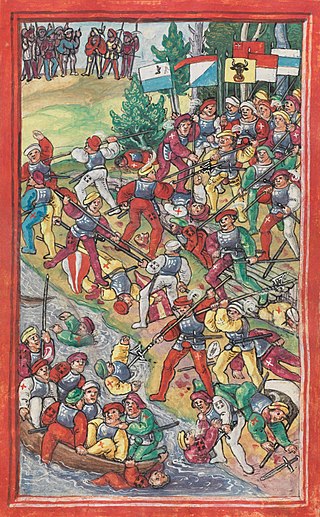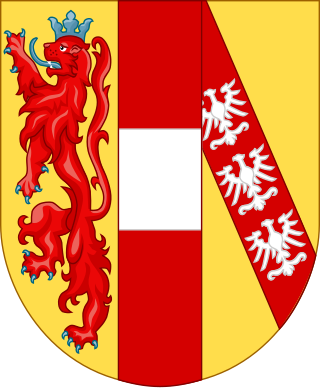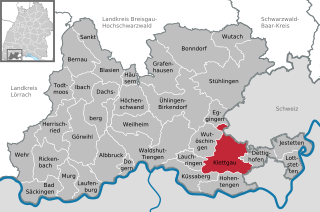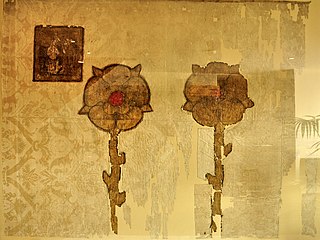Related Research Articles

The House of Habsburg, also known as the House of Austria, was one of the most prominent and important dynasties in European history.

The House of Zähringen was a dynasty of Swabian nobility. The family's name derived from Zähringen Castle near Freiburg im Breisgau. The Zähringer in the 12th century used the title of Duke of Zähringen, in compensation for having conceded the title of Duke of Swabia to the Staufer in 1098. The Zähringer were granted the special title of Rector of Burgundy in 1127, and they continued to use both titles until the extinction of the ducal line in 1218.

The Duchy of Burgundy emerged in the 9th century as one of the successors of the ancient Kingdom of the Burgundians, which after its conquest in 532 had formed a constituent part of the Frankish Empire. Upon the 9th-century partitions, the French remnants of the Burgundian kingdom were reduced to a ducal rank by King Robert II of France in 1004. Robert II's son and heir, King Henry I of France, inherited the duchy but ceded it to his younger brother Robert in 1032.

The Counts of Celje or the Counts of Cilli were the most influential late medieval noble dynasty on the territory of present-day Slovenia. Risen as vassals of the Habsburg dukes of Styria in the early 14th century, they ruled the County of Cilli as immediate counts (Reichsgrafen) from 1341. They soon acquired a large number of feudal possessions also in today's Croatia and Bosnia. They rose to Princes of the Holy Roman Empire in 1436. The dynasty reached its peak with Ulrich II of Cilli, but with his death in 1456 they also died out, and after a war of succession, the Habsburgs inherited their domains.

Hermann II, Count of Celje, was a Styrian prince and magnate, most notable as the faithful supporter and father-in-law of the Hungarian king and Holy Roman Emperor Sigismund of Luxembourg. Hermann's loyalty to the King ensured him generous grants of land and privileges that led him to become the greatest landowner in Slavonia. He served as governor of Carniola, and twice as ban of the combined provinces of Slavonia, Croatia and Dalmatia, and was recognized by a treaty in 1427 as heir presumptive to the Kingdom of Bosnia. The House of Celje's rise to power culminated in achieving the dignity of Prince of the Holy Roman Empire. At the peak of his power, he controlled two thirds of the land in Carniola, most of Lower Styria, and exercised power over all of medieval Croatia. Hermann was one of the most important representatives of the House of Celje, having brought the dynasty from regional importance to the foreground of Central European politics.

The Swabian War of 1499 (Alemannic German: Schwoobechrieg, called Schwabenkrieg or Schweizerkrieg in Germany and Engadiner Krieg was the last major armed conflict between the Old Swiss Confederacy and the House of Habsburg. What had begun as a local conflict over the control of the Val Müstair and the Umbrail Pass in the Grisons soon got out of hand when both parties called upon their allies for help; the Habsburgs demanding the support of the Swabian League, while the Federation of the Three Leagues of the Grisons turning to the Swiss Eidgenossenschaft. Hostilities quickly spread from the Grisons through the Rhine valley to Lake Constance and even to the Sundgau in southern Alsace, the westernmost part of the Habsburg region of Further Austria.

The House of Luxembourg or Luxembourg dynasty was a royal family of the Holy Roman Empire in the Late Middle Ages, whose members between 1308 and 1437 ruled as kings of Germany and Holy Roman emperors as well as kings of Bohemia, Hungary and Croatia. Their rule was twice interrupted by the rival House of Wittelsbach. The family takes its name from its ancestral county of Luxembourg which they continued to hold.

Habsburg Castle is a medieval fortress located in what is now Habsburg, Switzerland, in the canton of Aargau, near the Aar River. At the time of its construction, the location was part of the Duchy of Swabia. Habsburg Castle is the original seat of the House of Habsburg, which became one of the leading imperial and royal dynasties in Europe. It is listed as a Swiss heritage site of national significance.

Werner I, Count of Klettgau was a nobleman and an early member of the House of Habsburg. He was an ancestor of King Rudolph I of Germany.
Werner I, Bishop of Strasbourg served from 1002 until his death on 28 October 1028. Werner I may have been one of six sons of Lanzelin of Klettgau, and also the brother of Radbot of Klettgau, a founder of the Habsburg dynasty. However, the sources that identify Werner with this Habsburg lineage are apocryphal, and therefore his connection to the family has been questioned.

Radbot, Count of Klettgau was Graf (Count) of the county of Klettgau on the High Rhine in Swabia. Radbot was one of the progenitors of the Habsburg dynasty, and he chose to name his fortress Habsburg.

Otto II was a Graf (Count) of Habsburg and one of the founding members of the Habsburg family. He was the son of Werner I, Count of Habsburg. Otto II was likely born in the late 1050s or early 1060s. Otto inherited the county of Klettgau & Altembourg from his father; Werner I, Count of Habsburg.

The House of Schwarzenberg is a German (Franconian) and Czech (Bohemian) aristocratic family, formerly one of the most prominent European noble houses. The Schwarzenbergs are members of the German and Czech nobility, and they once held the rank of Princes of the Holy Roman Empire. The family belongs to the high nobility and traces its roots to the Lords of Seinsheim during the Middle Ages. The secundogeniture branch of the Schwarzenbergs was among the foremost Czech patriotic houses.

The House of Habsburg-Lorraine originated from the marriage in 1736 of Francis III, Duke of Lorraine and Bar, and Maria Theresa of Austria, later successively Queen of Bohemia, Queen of Hungary, Queen of Croatia and Archduchess of Austria. Its members form the legitimate surviving line of both the House of Habsburg and the House of Lorraine, and they inherited their patrimonial possessions from the female line of the House of Habsburg and from the male line of the House of Lorraine.

Klettgau is a municipality in the district of Waldshut in Baden-Württemberg, Germany. It is the center of the Klettgau historical region stretching across the Swiss border into the cantons of Aargau, Schaffhausen and Zürich.
The House of Sponheim or Spanheim was a medieval German noble family, which originated in Rhenish Franconia. They were immediate Counts of Sponheim until 1437 and Dukes of Carinthia from 1122 until 1269. Its cadet branches ruled in the Imperial County of Ortenburg-Neuortenburg and various Sayn-Wittgenstein states until 1806.

Guntram the Rich was a count in Breisgau, member of the noble family of the Etichonids, and possibly the progenitor of the House of Habsburg.

The House of Urach is a morganatic cadet branch of the formerly royal House of Württemberg. Although the Württemberg dynasty was one of many reigning over small realms in Germany into the 20th century, and despite the fact that marital mésalliances in these dynasties usually disinherited the descendants thereof, the Dukes of Urach unusually managed to elicit consideration for candidacy for the thrones of several European states, viz. the Kingdom of Württemberg, the abortive Kingdom of Lithuania, the Principality of Monaco and even the Principality of Albania. Although none of these prospects came to fruition, they reflected monarchical attempts to accommodate the rapid shifts in national allegiance, regime and international alliances that intensified throughout the 19th century, leading up to and following Europe's Great War of 1914–1918.

The House of Rapperswil respectively Counts of Rapperswil ruled the upper Zürichsee and Seedamm region around Rapperswil and parts of, as of today, Swiss cantons of St. Gallen, Glarus, Zürich and Graubünden when their influence was most extensive around the 1200s until the 1290s. They acted also as Vogt of the most influential Einsiedeln Abbey in the 12th and 13th century, and at least three abbots of Einsiedeln were members of Rapperswil family.

Frederick I of Celje, also Frederick I of Cilli, was a Styrian free noble who became the first Count of Celje, founding a noble house that would dominate Slovenian and Croatian history in the first half of the 15th century.
References
- ↑ "Lanzelin, count of Altenberg". geni_family_tree. 942. Retrieved 2022-01-31.
- ↑ Anzeiger für Schweizerische geschichte (in German). Buchdruckerei K. J. Wyss. 1889.
- ↑ "eberhard_3_graf_im_thurgau_971". www.manfred-hiebl.de. Retrieved 2022-01-30.
- ↑ Jaffé, Philipp; Wattenbach, Wilhelm; Dümmler, Ernst Ludwig (1864). Bibliotheca rerum germanicarum. New York Public Library. Berolini, apud Weidmannos.